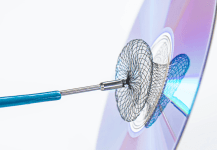In recent years, there has been a steady increase in the use of transcatheter aortic valve replacement (TAVR) in younger patients, with an average age of 74 years, as observed in US medical records. This trend goes alongside encouraging durability results, as demonstrated in the 10-year NOTION study, where structural valve degeneration (SVD) with first-generation…
TCT 2023 | The WATCH-TAVR Study
In the TVT registry, around 40% of the patients eligible for transcatheter aortic valve replacement (TAVR) had atrial fibrillation, and there were high levels of adverse events after starting anticoagulant treatment, especially with oral anticoagulants (VKAs), primarily due to bleeding. The purpose of this study was to assess the feasibility, safety, and efficacy of combined…
FLAME Study: FlowTriever Device in High-Risk Pulmonary Embolism
High-risk pulmonary embolism (HR-PE) is characterized by hemodynamic instability and marked deformation of the right ventricular (RV) fiber, which can lead to acute RV failure and hemodynamic collapse, with in-hospital mortality close to 25%. While guidelines recommend anticoagulant treatment followed by thrombolytics, these strategy carries a high risk of bleeding and is not suitable for…
OBSERVANT II: Post TAVR 30-Day and 6-Month Stroke Predictors
Despite stroke rate has declined since the early days of transcatheter aortic valve replacement (TAVR), it remains significant, reaching 1% to 3% 30 days after procedure. Since TAVR has seen a progressive expansion to the low risk and young populations, identifying risk factors in patient selection and management is crucial for us to prevent stroke. …
Cause of Cardiac Death after TAVR at Present
Cardiac failure (CF) and sudden cardiac death (SCD) stand out as two of the main causes of death in patients with aortic stenosis. Although transcatheter aortic valve intervention has shown higher survival, these two continue to be the main conditions leading to patient death at followup. In its early days, TAVR also showed benefits, but…
Transcatheter Closure of Patent Foramen Ovale in Thrombophilia Patients
The transcatheter treatment of patent foramen ovale (PFO) has been shown to reduce thromboembolic events in patients with cryptogenic stroke. However, most of large randomized studies have failed to include patients with thrombophilia, either inherited or acquired. For instance, the RESPECT study excluded patients with antiphospholipid antibodies (AFA) or hyperhomocysteinemia, while the REDUCE screened for…
TAVR in Asymptomatic or Minimally Symptomatic Patients: 30-Day Results
Aortic valve replacement (AVR) is recommended for symptomatic aortic stenosis (AS), while close monitoring is the advised strategy for asymptomatic patients, unless they have elevated aortic gradients, reduced ejection fraction, or abnormal stress tests. However, the optimal timing for AVR remains uncertain, especially in light of recent evidence suggesting that AS patients showing signs of…
MITRAL Trial, Results at 5 Years
Repeat mitral valve repair has been associated with increased mortality. Transcatheter mitral valve repair has surged as an alternative for patients treated with mitral valve-in-valve (MViV), valve-in-ring (MViR), or valve-in-mitral for annular calcification (ViMAC). Current data from the VIVID and the MAC Global Registry on 30-day evolution in these 3 scenarios show 7.4%, 11.4% and…
TRILUMINATE Two Years In: Encouraging Results
Tricuspid valve regurgitation is more common than one might think. It often stems from left valve disease and associated with increased mortality and hospitalization due to heart failure, which is not easy to treat. Currently, guidelines list surgery as the recommended treatment, though this option is quite complex and might entail complications and mortality risk.…
TAVI-in-TAVI with Balloon-Expandable Valves
TAVI (Transcatheter Aortic Valve Implantation) has proven to be beneficial and is currently performed in increasingly younger and lower-risk patients. However, as with surgical bioprostheses, structural deterioration, whether due to stenosis or regurgitation, is one of the challenges we must address. While currently uncommon, this is an issue we will probably see more and more…
Post-TAVI Prosthesis-Patient Mismatch
Prosthesis-patient mismatch (PPM) occurs when the effective orifice area (EOA) after valve placement is significantly smaller compared with the patient’s body surface area (BSA), resulting in an increased transprosthetic residual gradient. The presence of PPM, especially in various surgical series, has been associated with long-term adverse clinical events. In relation to transcatheter aortic valve implantation…










